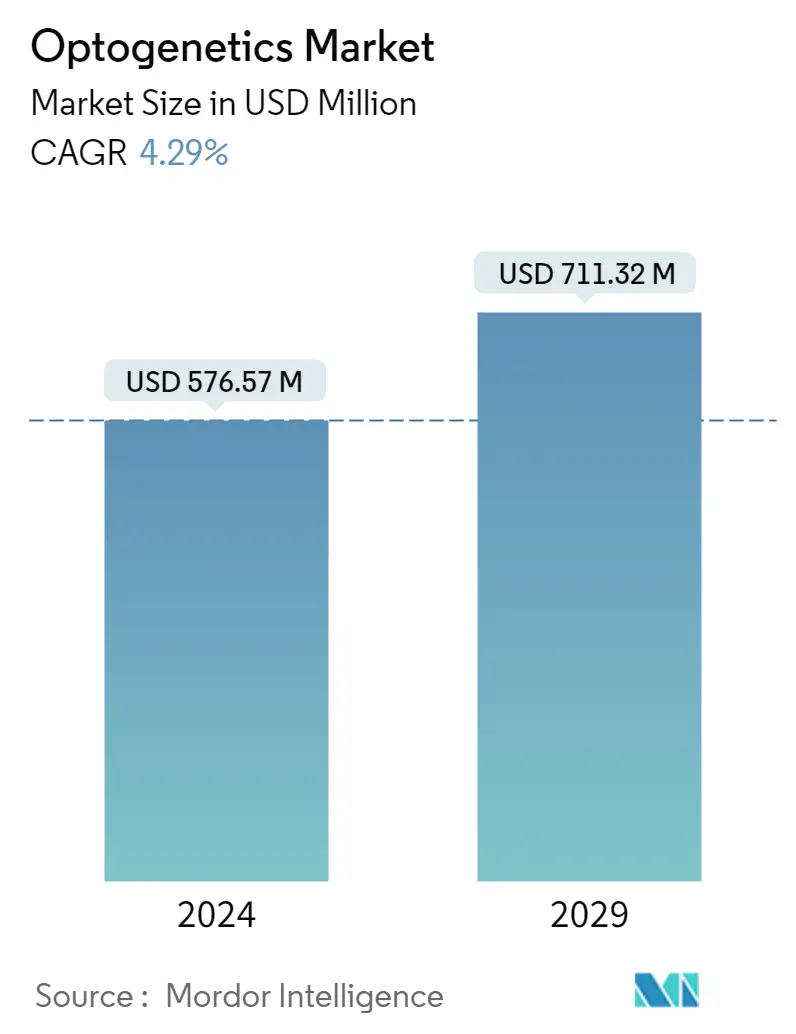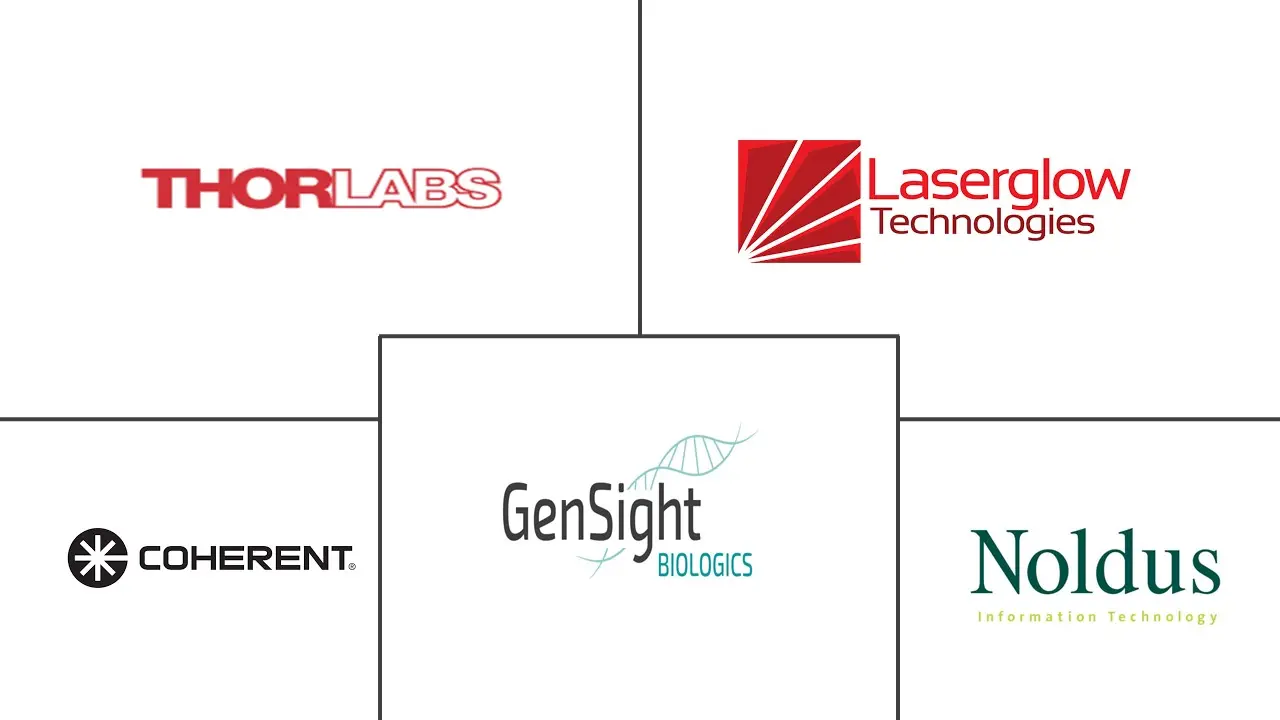Market Size of Optogenetics Industry

| Study Period | 2019 - 2029 |
| Market Size (2024) | USD 576.57 Million |
| Market Size (2029) | USD 711.32 Million |
| CAGR (2024 - 2029) | 4.29 % |
| Fastest Growing Market | Asia Pacific |
| Largest Market | North America |
Major Players
*Disclaimer: Major Players sorted in no particular order |
Optogenetics Market Analysis
The Optogenetics Market size is estimated at USD 576.57 million in 2024, and is expected to reach USD 711.32 million by 2029, growing at a CAGR of 4.29% during the forecast period (2024-2029).
The COVID-19 pandemic is expected to impact the optogenetics market significantly. According to the article published by PUS University in February 2022 by Shanet Suzan Alex, SARS-CoV-2 causes neurological abnormalities and respiratory symptoms, with an 85% occurrence rate in Alzheimer's patients. As per the same source, SARS-CoV-2 infiltrated COVID-19 patients' cognitive centers, causing Alzheimer's-like phenotypes in those with no underlying conditions and exacerbating Alzheimer's neuropathology in those with Alzheimer's and autism. As a result, COVID-19 had many complications in patients with neurological disorders, and the market was significantly impacted. However, as the pandemic has currently subsided, neurology care has gone back to pre-pandemic levels, which are expected to increase the adoption of optogenetic products and lead to a normal market growth over the forecast period.
The major factors driving the market's growth include the scope of optogenetics as a potential diagnostic tool in neurosciences, the rapid growth of advanced technologies, and the increasing use of multimodal imaging. Optogenetics technology has revolutionized neuroscience in the last few years by allowing researchers to control specific neurons in experimental animals. The ability to control neurons has revealed information about brain pathways involved in diseases such as depression, obsessive-compulsive disorders, Parkinson's disease, and other conditions. In neural research, optogenetic methods for monitoring synaptic activity have proven to be extremely useful in several neurological diseases.
It allows researchers to study how the neurological activity patterns within specific brain cells give rise to thoughts, behaviors, and memories at unprecedented precision. Thus, it helps find cures and treatments for neurological and psychiatric disorders like depression, addiction, schizophrenia, and Parkinson's disease. For instance, according to the article published by Frontiers in April 2022, Parkinson's disease is said to be a chronic disease with no clinical cure. However, it can be alleviated and treated with optogenetics. Thus, the use of optogenetics in the treatment of Parkinson's proved a potent tool used to treat neurological diseases.
Also, rising cases of neurological disorders such as Parkinson's, Alzheimer's, epilepsy, and Huntington's disease may boost the market. According to an article published by scientific reports in October 2022, Parkinson's disease (PD) is often associated with dementia, and dementia causes a substantial negative impact on the affected individual, their care partners, and society. The affected individual loses their ability to function independently and faces a reduced survival and health-related quality of life. The article also reported that the cumulative prevalence of Parkinson's disease in the last 10 years in Sweden was 54%. Thus, the high burden of Parkinson's disease is expected to boost the usage of optogenetics.
The rising developments by major players are also expected to boost the market's growth. For instance, in September 2021, TSE Systems, one of the leaders in advanced preclinical research equipment for metabolic and behavioral research, and NeuroLux, the developer of battery-free wireless optogenetics implants for preclinical research, announced an exclusive partnership.
Hence, factors such as the increasing use of optogenetics for the treatment of neurological disorders, the rising prevalence of neurological diseases, and the increasing developments by key players are expected to boost the market's growth. However, a lack of awareness and the high costs of technology may restrain this growth over the forecast period.
Optogenetics Industry Segmentation
As per the report's scope, optogenetics refers to a range of optical techniques used to elicit a physiological response in targeted biological systems without pharmacology and electric stimulations. Optogenetics controls neural activity by combining genetic engineering and optical tools. It is widely used in neuroscience for the modulation of neural circuits with high precision and specificity.
The optogenetics market is segmented by light equipment (laser and light-emitting diode), actuator (channelrhodopsin, halorhodopsin, and archaerhodopsin), sensor (calcium (aequorin, cameleon, and other calcium sensors), chloride (clomeleon), membrane-gated (mermaid), and other sensors), application (neuroscience, behavioral tracking, retinal, disease treatment, and other applications), and geography (North America, Europe, Asia-Pacific, Middle East and Africa, and South America). The report also covers the estimated market sizes and trends for 17 countries globally. The report offers the value (USD million) for the above segments.
| By Light Equipment | |
| Laser | |
| Light-emitting Diode (LED) |
| By Actuator | |
| Channelrhodopsin | |
| Halorhodopsin | |
| Archaerhodopsin |
| By Sensor | |
| Calcium (Aequorin, Cameleon, and Other Calcium Sensors) | |
| Chloride (Clomeleon) | |
| Membrane-gated (Mermaid) | |
| Other Sensors |
| By Application | |
| Neuroscience | |
| Behavioral Tracking | |
| Retinal Disease Treatment | |
| Other Applications |
| By Geography | ||||||||
| ||||||||
| ||||||||
| ||||||||
| ||||||||
|
Optogenetics Market Size Summary
The optogenetics market is poised for steady growth over the forecast period, driven by advancements in neuroscience and the increasing application of optogenetics as a diagnostic and therapeutic tool. The technology has transformed the field by enabling precise control of neuronal activity, offering insights into brain pathways associated with various neurological and psychiatric disorders. This capability is particularly valuable in understanding and potentially treating conditions such as depression, Parkinson's disease, and Alzheimer's disease. The market's expansion is further supported by the rising prevalence of neurological disorders, which underscores the need for innovative treatment solutions. Additionally, collaborations and developments by key industry players are expected to enhance market dynamics, despite challenges such as high costs and limited awareness.
North America is anticipated to lead the optogenetics market, fueled by the high burden of chronic diseases and robust research activities in the region. The region benefits from significant government initiatives and funding, which facilitate the entry of multiple players and the development of cutting-edge solutions. The increasing patient population and the demand for advanced neurological care are key factors driving market growth. The market is moderately consolidated, with major players focusing on research and development, acquisitions, and strategic collaborations to maintain their competitive edge. These efforts are complemented by technological advancements, such as the integration of light-emitting diodes in optogenetic devices, which enhance the efficacy and accessibility of treatments.
Optogenetics Market Size - Table of Contents
-
1. MARKET DYNAMICS
-
1.1 Market Drivers
-
1.1.1 Potential Diagnostic Tool in the Field of Neurosciences
-
1.1.2 Rapid Growth of Advanced Technology
-
1.1.3 Increasing Use of Multimodal Imaging
-
-
1.2 Market Restraints
-
1.2.1 High Cost of Technology
-
1.2.2 Lack of Awareness
-
-
1.3 Porter's Five Forces Analysis
-
1.3.1 Threat of New Entrants
-
1.3.2 Bargaining Power of Buyers/Consumers
-
1.3.3 Bargaining Power of Suppliers
-
1.3.4 Threat of Substitute Products
-
1.3.5 Intensity of Competitive Rivalry
-
-
-
2. MARKET SEGMENTATION (Market Size by Value - USD million)
-
2.1 By Light Equipment
-
2.1.1 Laser
-
2.1.2 Light-emitting Diode (LED)
-
-
2.2 By Actuator
-
2.2.1 Channelrhodopsin
-
2.2.2 Halorhodopsin
-
2.2.3 Archaerhodopsin
-
-
2.3 By Sensor
-
2.3.1 Calcium (Aequorin, Cameleon, and Other Calcium Sensors)
-
2.3.2 Chloride (Clomeleon)
-
2.3.3 Membrane-gated (Mermaid)
-
2.3.4 Other Sensors
-
-
2.4 By Application
-
2.4.1 Neuroscience
-
2.4.2 Behavioral Tracking
-
2.4.3 Retinal Disease Treatment
-
2.4.4 Other Applications
-
-
2.5 By Geography
-
2.5.1 North America
-
2.5.1.1 United States
-
2.5.1.2 Canada
-
2.5.1.3 Mexico
-
-
2.5.2 Europe
-
2.5.2.1 Germany
-
2.5.2.2 United Kingdom
-
2.5.2.3 France
-
2.5.2.4 Italy
-
2.5.2.5 Spain
-
2.5.2.6 Rest of Europe
-
-
2.5.3 Asia-Pacific
-
2.5.3.1 China
-
2.5.3.2 Japan
-
2.5.3.3 India
-
2.5.3.4 Australia
-
2.5.3.5 South Korea
-
2.5.3.6 Rest of Asia-Pacific
-
-
2.5.4 Middle East and Africa
-
2.5.4.1 GCC
-
2.5.4.2 South Africa
-
2.5.4.3 Rest of Middle East and Africa
-
-
2.5.5 South America
-
2.5.5.1 Brazil
-
2.5.5.2 Argentina
-
2.5.5.3 Rest of South America
-
-
-
Optogenetics Market Size FAQs
How big is the Optogenetics Market?
The Optogenetics Market size is expected to reach USD 576.57 million in 2024 and grow at a CAGR of 4.29% to reach USD 711.32 million by 2029.
What is the current Optogenetics Market size?
In 2024, the Optogenetics Market size is expected to reach USD 576.57 million.

